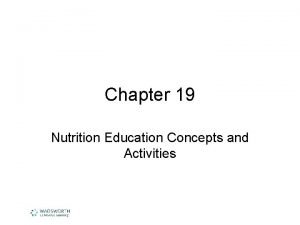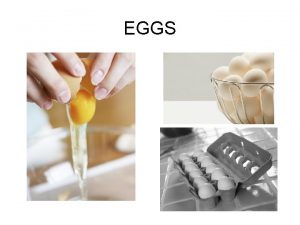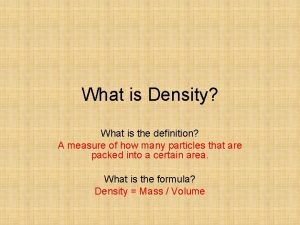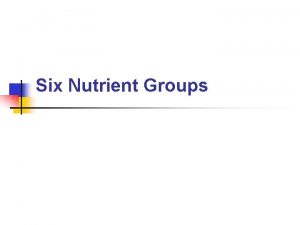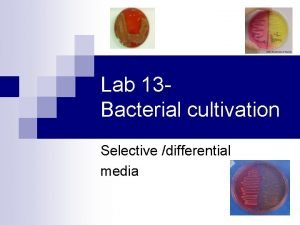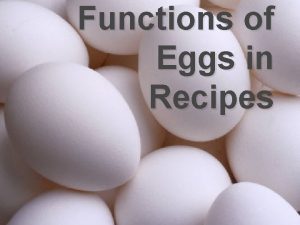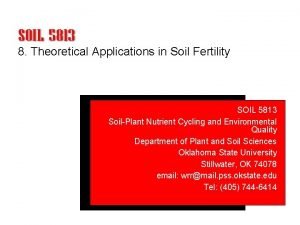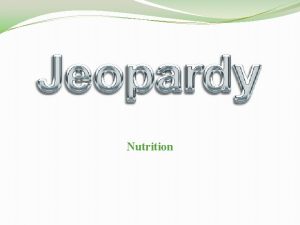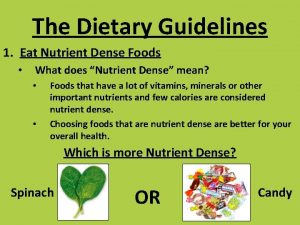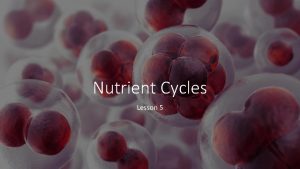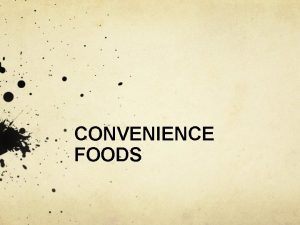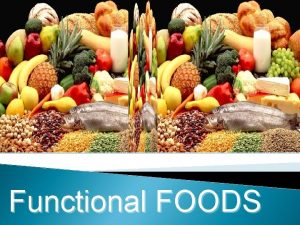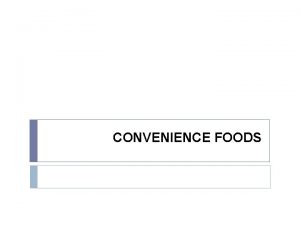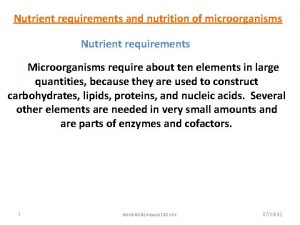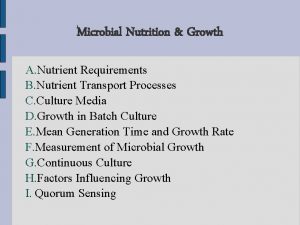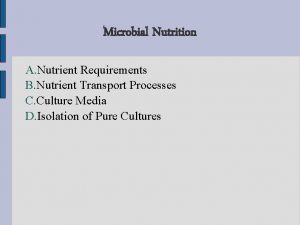Foods I Nutrition Unit Nutrient Dense Foodswhat does














- Slides: 14

Foods I Nutrition Unit Nutrient Dense Foods…what does it all mean? Nutrient-dense foods have a high nutrient/ low calorie ratio. Meaning they are rich in nutrients when compared to their calorie content such as fresh fruits, vegetables, and whole grains.

Grains (Dietary Fiber, B vitamins) l Any food made from wheat, rice, oats, cornmeal, or barley. • l Examples: bread, pasta, oatmeal, and cereals Misc. Fact: Most products are “refined”…check for the word “WHOLE”. Whole Grains Vs. Refined Grains

Make Half Your Grains Whole l Make at least half the grains you eat whole grains. • l l Eat three or more whole-grain foods each day (for a 2, 000 calorie diet). Have the remainder come from enriched grain products. Refined grains are milled- the bran and germ are removed –so are many of the B vitamins, iron, and fiber. • Refined grains can be enriched. Certain B vitamins (thiamin, riboflavin, niacin, folic acid) and iron are added back in. Fiber is not added back to most enriched grains.

Proteins (Vitamins, Minerals, Oils) l All foods from meat, poultry, fish, dry beans/peas, eggs, or nuts/seeds. • l Examples: beef, chicken, eggs, black beans, almonds, tuna, and shrimp. Misc Fact: Most meat/poultry choices should be leans or low-fat (75 -80%). Liver and organ meats are high in cholesterol while processed meats are high in sodium. Meats Poultry Eggs

Go Lean with Protein l l Eat 5. 5 oz of meat & beans a day (based on 2, 000 calorie diet). 1 oz. from the meat & beans group = • • • l l l 1 oz. lean meat, poultry, or fish 1 egg 1 tbsp. peanut butter ¼ cup cooked dry beans or peas ½ oz. nuts or seeds Make lean choices Vary your choices. Try fish, eggs, beans, peas, nuts, and seeds. Bake, broil, or grill meat.

Dairy (Vitamins, Minerals) l Any fluid milk products and other food made from milk. • l Examples: ice cream, pudding, cheese, milk, yogurt. Misc. Fact: Cream cheese, cream, and butter have little to no calcium… therefore they are not part of the milk group. Most choices should be low-fat or fat-free. Milk Cheese Yogurt

Get Calcium-Rich Foods l l Eat or drink 3 cups from the milk group every day (based on 2, 000 calorie diet). 1 cup from the milk group = • • l 1 cup milk (8 oz. ) 1 cup yogurt 1. 5 oz. natural cheese (the size of two dominoes) 2 oz. processed cheese (two slices) Choose fat-free or low-fat.

Get Rich with Calcium by Choosing Dairy l Adults and children over age 9: • 3 cups (8 oz. each, total of 24 oz. ) per day of fat-free or low-fat milk or milk products, such as: • 1 cup yogurt • 1. 5 oz. natural cheese l Children ages 2 to 8: • 2 cups per day

Vegetables (Vitamins, Minerals) l Any vegetable or 100% vegetable juice. • l Dark Green Orange Dry Beans Misc. Vegetables Examples: vegetables may be raw, cooked, fresh, frozen, canned, or dried. Misc. Fact: Vegetables are organized into 5 subgroups based on Nutrient content. Starchy

Vary Your Veggies l Eat 2 ½ cups of veggies a day (based on 2, 000 calorie diet). • • • l Fresh, frozen, canned, dried vegetables, or vegetable juice. 1 cup raw or cooked vegetables is about the size of a clenched fist. 2 cups of leafy greens = 1 cup in the vegetable group. Select from all 5 vegetable subgroups several times a week. • • • Dark Green Orange Legumes Starchy Other

Fruits (Vitamins, Minerals) l Any fruit or 100% fruit juice. • l Melons Berries Citrus Tropical Pomes Drupes Examples: fresh, canned, frozen, or dried. Misc. Fact: Fruit may be whole, cutup, or pureed.

Focus on Fruits l l Eat 2 cups of fruit a day (based on a 2, 000 calorie diet). 1 cup from the fruit group = • • • 1 cup fruit 1 cup 100% fruit juice ½ cup dried fruit Select fresh, frozen, canned, or dried fruit, more often than fruit juice. Think color! The more color, the more nutrients!

Oils l Ø Ø Monounsaturated fats are healthy oils and can decrease cancers, diabetes, obesity, heart disease, etc. …examples are: Olive Oil Canola Oil FYI…”Blend” oils like Crisco do NOT contain trans fatty acids

10 Tips to a Great Plate 1. 2. 3. 4. 5. Balance calories. Enjoy your food, but eat less. Avoid oversized portions. Foods to eat more often. Make half your plate fruits and vegetables. 6. 7. 8. 9. 10. Switch to fat-free or low-fat (1%) milk. Make half your grains whole grains. Foods to eat less often. Compare sodium in foods. Drink water instead of sugary drinks. http: //www. choosemyplate. gov/foodgroups/downloads/Ten. Tips/DGTipshe et 1 Choose. My. Plate. pdf
 Foods used in nutrition activities should be nutrient-dense
Foods used in nutrition activities should be nutrient-dense Example of complex media
Example of complex media Interfering agent eggs
Interfering agent eggs Crust outer core inner core mantle
Crust outer core inner core mantle The layers of earth from most dense to least dense
The layers of earth from most dense to least dense The earth's layers foldable
The earth's layers foldable Nutrient cycle of a tropical rainforest
Nutrient cycle of a tropical rainforest More density
More density Upper limb
Upper limb Six nutrient groups
Six nutrient groups Nutrient agar with tellurite is selective/differential for
Nutrient agar with tellurite is selective/differential for Nutrient additive eggs
Nutrient additive eggs Nutrient cycle in the serengeti
Nutrient cycle in the serengeti Deciduous woodland nutrient cycle
Deciduous woodland nutrient cycle Brays nutrient mobility concept
Brays nutrient mobility concept
